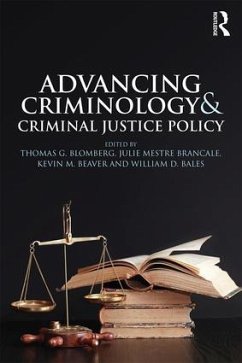Advancing Criminology and Criminal Justice Policy
Herausgeber: Blomberg, Thomas; Bales, William; Beaver, Kevin; Brancale, Julie
Advancing Criminology and Criminal Justice Policy
Herausgeber: Blomberg, Thomas; Bales, William; Beaver, Kevin; Brancale, Julie
- Broschiertes Buch
- Merkliste
- Auf die Merkliste
- Bewerten Bewerten
- Teilen
- Produkt teilen
- Produkterinnerung
- Produkterinnerung
This book offers an authoritative and comprehensive overview of criminal justice policy from crime prevention to rehabilitation and brings together leading experts in the field to discuss how criminology can advance sound and evidence-based policy.
Andere Kunden interessierten sich auch für
![Criminal Justice and Criminology Research Methods Criminal Justice and Criminology Research Methods]() Peter KraskaCriminal Justice and Criminology Research Methods111,99 €
Peter KraskaCriminal Justice and Criminology Research Methods111,99 €![Police Administration Police Administration]() Gary W. CordnerPolice Administration111,99 €
Gary W. CordnerPolice Administration111,99 €![Juvenile Justice Juvenile Justice]() John T. Whitehead (USA East Tennessee State University)Juvenile Justice126,99 €
John T. Whitehead (USA East Tennessee State University)Juvenile Justice126,99 €![Justice for All Justice for All]() Charles MacLean (Charles 'Chuck' MacLean, J.D., Ph.D., is an AssociJustice for All55,99 €
Charles MacLean (Charles 'Chuck' MacLean, J.D., Ph.D., is an AssociJustice for All55,99 €![Criminology, Crime and Justice in Ireland Criminology, Crime and Justice in Ireland]() James WindleCriminology, Crime and Justice in Ireland73,99 €
James WindleCriminology, Crime and Justice in Ireland73,99 €![Criminology Criminology]() Stephen E. BrownCriminology113,99 €
Stephen E. BrownCriminology113,99 €![The Psychology of Criminal Conduct The Psychology of Criminal Conduct]() James BontaThe Psychology of Criminal Conduct119,99 €
James BontaThe Psychology of Criminal Conduct119,99 €-
-
-
This book offers an authoritative and comprehensive overview of criminal justice policy from crime prevention to rehabilitation and brings together leading experts in the field to discuss how criminology can advance sound and evidence-based policy.
Hinweis: Dieser Artikel kann nur an eine deutsche Lieferadresse ausgeliefert werden.
Hinweis: Dieser Artikel kann nur an eine deutsche Lieferadresse ausgeliefert werden.
Produktdetails
- Produktdetails
- Verlag: Taylor & Francis Ltd
- Seitenzahl: 476
- Erscheinungstermin: 29. März 2016
- Englisch
- Abmessung: 234mm x 156mm x 26mm
- Gewicht: 792g
- ISBN-13: 9781138829237
- ISBN-10: 1138829234
- Artikelnr.: 43751789
- Herstellerkennzeichnung
- Libri GmbH
- Europaallee 1
- 36244 Bad Hersfeld
- gpsr@libri.de
- Verlag: Taylor & Francis Ltd
- Seitenzahl: 476
- Erscheinungstermin: 29. März 2016
- Englisch
- Abmessung: 234mm x 156mm x 26mm
- Gewicht: 792g
- ISBN-13: 9781138829237
- ISBN-10: 1138829234
- Artikelnr.: 43751789
- Herstellerkennzeichnung
- Libri GmbH
- Europaallee 1
- 36244 Bad Hersfeld
- gpsr@libri.de
Thomas G. Blomberg is Dean and Sheldon L. Messinger Professor of Criminology, and Executive Director of the Center for Criminology and Public Policy Research at Florida State University, USA. Julie Mestre Brancale is a doctoral candidate and graduate research assistant for the Center for Criminology and Public Policy Research at Florida State University, USA. Kevin M. Beaver is Professor in the College of Criminology and Criminal Justice at Florida State University, USA. William D. Bales is Professor in the College of Criminology and Criminal Justice at Florida State University, USA.
Volume Introduction: Advancing Criminology and Criminal Justice Policy
PART I: Introduction Introduction: Evidence, Evaluation, and Strategies for
Moving Criminal Justice Policy Forward 1. Evidence-Informed Criminal
Justice Policy: Looking Back, Moving Forward 2. Policy Evaluation and
Assessment 3. The Role of Theory, Ideology, and Ethics in Criminal Justice
Policy 4. Translational Criminology: A New Path Forward PART II: Crime
Prevention Introduction: Individual, Family, and Community Prevention
Programs 5. Juvenile Delinquency Prevention Programs 6. Opportunities for
Public Policies to Strengthen Families and Prevent Crime 7. Community Crime
Prevention 8. Situational crime prevention PART III: Policing and Court
Sentencing Introduction: Policing 9. Community Policing 10.
Problem-Oriented Policing: Evidence v. Framing in Implementation Success
11. The Science and Practice of Hot-Spots Policing Anthony Braga
Introduction: Court Sentencing 12. Mandatory Minimum Penalties:
Evidence-Based Consequences and Recommendations for Policy and Legal Reform
13. Sentencing Disparities 14. Sex Offender Legislation and Policy 15. Drug
Courts and Drug Policy 16. Did the Gregg Decision Overcome the Arbitrary
and Discriminatory Use of the Death Penalty So Prevalent in Furman? PART
IV: Corrections and Rehabilitation Introduction: Community Corrections 17.
Improving Correctional Supervision: What does the Research Tell Us? 18.
Smart Sentencing Revisited: Assessing the Policy/ Practice Implications of
Research on Electronic Monitoring and other Intermediate Sanctions
Introduction: IncarcerationEditors 19. Confinement in Local Jails:
Institutions and Their Clients Neglected by Criminologists 20. Does a
Prison Term Prevent or Promote More Crime? Introduction: Reentry and
Recidivism Reduction Programs 21. Reentry from Incarceration to Community:
A Convergence of Practices based on Scientific Evidence to Enhance
Citizenship 22. The Effects of Prison Programming 23. The Challenge of
Integrating Restorative Justice into the "Deep-End" of Criminal Justice
24. Juvenile Justice Education Introduction: Special Populations 25.
Inmates with Serious Mental Illnesses: Current Knowledge and Challenges for
Practice 26. Women's Incarceration and Motherhood: Policy Considerations
27. Aging and Dying in Prison: At the Intersection of Crime, Costs, and
Healthcare 28. Native American Criminal Justice: Toward Evidence-Based
Policy and Practice PART V: Conclusion Introduction: The Future of
Criminology and Criminal Justice Policy 29. Mass Incarceration, the
Carceral State, and Evidence-Based Research 30. The Media and Criminal
Justice Policy and Practices 31. Cost-Effective and Accountable Criminal
Justice Policy 32. The Utility of Findings from Biosocial Research for
Public Policy 33. Bringing Evidence into Criminal Justice Policy
PART I: Introduction Introduction: Evidence, Evaluation, and Strategies for
Moving Criminal Justice Policy Forward 1. Evidence-Informed Criminal
Justice Policy: Looking Back, Moving Forward 2. Policy Evaluation and
Assessment 3. The Role of Theory, Ideology, and Ethics in Criminal Justice
Policy 4. Translational Criminology: A New Path Forward PART II: Crime
Prevention Introduction: Individual, Family, and Community Prevention
Programs 5. Juvenile Delinquency Prevention Programs 6. Opportunities for
Public Policies to Strengthen Families and Prevent Crime 7. Community Crime
Prevention 8. Situational crime prevention PART III: Policing and Court
Sentencing Introduction: Policing 9. Community Policing 10.
Problem-Oriented Policing: Evidence v. Framing in Implementation Success
11. The Science and Practice of Hot-Spots Policing Anthony Braga
Introduction: Court Sentencing 12. Mandatory Minimum Penalties:
Evidence-Based Consequences and Recommendations for Policy and Legal Reform
13. Sentencing Disparities 14. Sex Offender Legislation and Policy 15. Drug
Courts and Drug Policy 16. Did the Gregg Decision Overcome the Arbitrary
and Discriminatory Use of the Death Penalty So Prevalent in Furman? PART
IV: Corrections and Rehabilitation Introduction: Community Corrections 17.
Improving Correctional Supervision: What does the Research Tell Us? 18.
Smart Sentencing Revisited: Assessing the Policy/ Practice Implications of
Research on Electronic Monitoring and other Intermediate Sanctions
Introduction: IncarcerationEditors 19. Confinement in Local Jails:
Institutions and Their Clients Neglected by Criminologists 20. Does a
Prison Term Prevent or Promote More Crime? Introduction: Reentry and
Recidivism Reduction Programs 21. Reentry from Incarceration to Community:
A Convergence of Practices based on Scientific Evidence to Enhance
Citizenship 22. The Effects of Prison Programming 23. The Challenge of
Integrating Restorative Justice into the "Deep-End" of Criminal Justice
24. Juvenile Justice Education Introduction: Special Populations 25.
Inmates with Serious Mental Illnesses: Current Knowledge and Challenges for
Practice 26. Women's Incarceration and Motherhood: Policy Considerations
27. Aging and Dying in Prison: At the Intersection of Crime, Costs, and
Healthcare 28. Native American Criminal Justice: Toward Evidence-Based
Policy and Practice PART V: Conclusion Introduction: The Future of
Criminology and Criminal Justice Policy 29. Mass Incarceration, the
Carceral State, and Evidence-Based Research 30. The Media and Criminal
Justice Policy and Practices 31. Cost-Effective and Accountable Criminal
Justice Policy 32. The Utility of Findings from Biosocial Research for
Public Policy 33. Bringing Evidence into Criminal Justice Policy
Volume Introduction: Advancing Criminology and Criminal Justice Policy
PART I: Introduction Introduction: Evidence, Evaluation, and Strategies for
Moving Criminal Justice Policy Forward 1. Evidence-Informed Criminal
Justice Policy: Looking Back, Moving Forward 2. Policy Evaluation and
Assessment 3. The Role of Theory, Ideology, and Ethics in Criminal Justice
Policy 4. Translational Criminology: A New Path Forward PART II: Crime
Prevention Introduction: Individual, Family, and Community Prevention
Programs 5. Juvenile Delinquency Prevention Programs 6. Opportunities for
Public Policies to Strengthen Families and Prevent Crime 7. Community Crime
Prevention 8. Situational crime prevention PART III: Policing and Court
Sentencing Introduction: Policing 9. Community Policing 10.
Problem-Oriented Policing: Evidence v. Framing in Implementation Success
11. The Science and Practice of Hot-Spots Policing Anthony Braga
Introduction: Court Sentencing 12. Mandatory Minimum Penalties:
Evidence-Based Consequences and Recommendations for Policy and Legal Reform
13. Sentencing Disparities 14. Sex Offender Legislation and Policy 15. Drug
Courts and Drug Policy 16. Did the Gregg Decision Overcome the Arbitrary
and Discriminatory Use of the Death Penalty So Prevalent in Furman? PART
IV: Corrections and Rehabilitation Introduction: Community Corrections 17.
Improving Correctional Supervision: What does the Research Tell Us? 18.
Smart Sentencing Revisited: Assessing the Policy/ Practice Implications of
Research on Electronic Monitoring and other Intermediate Sanctions
Introduction: IncarcerationEditors 19. Confinement in Local Jails:
Institutions and Their Clients Neglected by Criminologists 20. Does a
Prison Term Prevent or Promote More Crime? Introduction: Reentry and
Recidivism Reduction Programs 21. Reentry from Incarceration to Community:
A Convergence of Practices based on Scientific Evidence to Enhance
Citizenship 22. The Effects of Prison Programming 23. The Challenge of
Integrating Restorative Justice into the "Deep-End" of Criminal Justice
24. Juvenile Justice Education Introduction: Special Populations 25.
Inmates with Serious Mental Illnesses: Current Knowledge and Challenges for
Practice 26. Women's Incarceration and Motherhood: Policy Considerations
27. Aging and Dying in Prison: At the Intersection of Crime, Costs, and
Healthcare 28. Native American Criminal Justice: Toward Evidence-Based
Policy and Practice PART V: Conclusion Introduction: The Future of
Criminology and Criminal Justice Policy 29. Mass Incarceration, the
Carceral State, and Evidence-Based Research 30. The Media and Criminal
Justice Policy and Practices 31. Cost-Effective and Accountable Criminal
Justice Policy 32. The Utility of Findings from Biosocial Research for
Public Policy 33. Bringing Evidence into Criminal Justice Policy
PART I: Introduction Introduction: Evidence, Evaluation, and Strategies for
Moving Criminal Justice Policy Forward 1. Evidence-Informed Criminal
Justice Policy: Looking Back, Moving Forward 2. Policy Evaluation and
Assessment 3. The Role of Theory, Ideology, and Ethics in Criminal Justice
Policy 4. Translational Criminology: A New Path Forward PART II: Crime
Prevention Introduction: Individual, Family, and Community Prevention
Programs 5. Juvenile Delinquency Prevention Programs 6. Opportunities for
Public Policies to Strengthen Families and Prevent Crime 7. Community Crime
Prevention 8. Situational crime prevention PART III: Policing and Court
Sentencing Introduction: Policing 9. Community Policing 10.
Problem-Oriented Policing: Evidence v. Framing in Implementation Success
11. The Science and Practice of Hot-Spots Policing Anthony Braga
Introduction: Court Sentencing 12. Mandatory Minimum Penalties:
Evidence-Based Consequences and Recommendations for Policy and Legal Reform
13. Sentencing Disparities 14. Sex Offender Legislation and Policy 15. Drug
Courts and Drug Policy 16. Did the Gregg Decision Overcome the Arbitrary
and Discriminatory Use of the Death Penalty So Prevalent in Furman? PART
IV: Corrections and Rehabilitation Introduction: Community Corrections 17.
Improving Correctional Supervision: What does the Research Tell Us? 18.
Smart Sentencing Revisited: Assessing the Policy/ Practice Implications of
Research on Electronic Monitoring and other Intermediate Sanctions
Introduction: IncarcerationEditors 19. Confinement in Local Jails:
Institutions and Their Clients Neglected by Criminologists 20. Does a
Prison Term Prevent or Promote More Crime? Introduction: Reentry and
Recidivism Reduction Programs 21. Reentry from Incarceration to Community:
A Convergence of Practices based on Scientific Evidence to Enhance
Citizenship 22. The Effects of Prison Programming 23. The Challenge of
Integrating Restorative Justice into the "Deep-End" of Criminal Justice
24. Juvenile Justice Education Introduction: Special Populations 25.
Inmates with Serious Mental Illnesses: Current Knowledge and Challenges for
Practice 26. Women's Incarceration and Motherhood: Policy Considerations
27. Aging and Dying in Prison: At the Intersection of Crime, Costs, and
Healthcare 28. Native American Criminal Justice: Toward Evidence-Based
Policy and Practice PART V: Conclusion Introduction: The Future of
Criminology and Criminal Justice Policy 29. Mass Incarceration, the
Carceral State, and Evidence-Based Research 30. The Media and Criminal
Justice Policy and Practices 31. Cost-Effective and Accountable Criminal
Justice Policy 32. The Utility of Findings from Biosocial Research for
Public Policy 33. Bringing Evidence into Criminal Justice Policy








